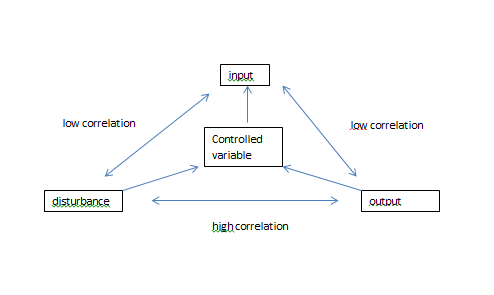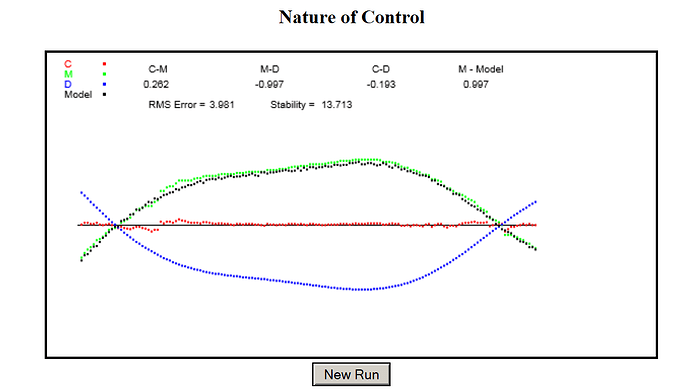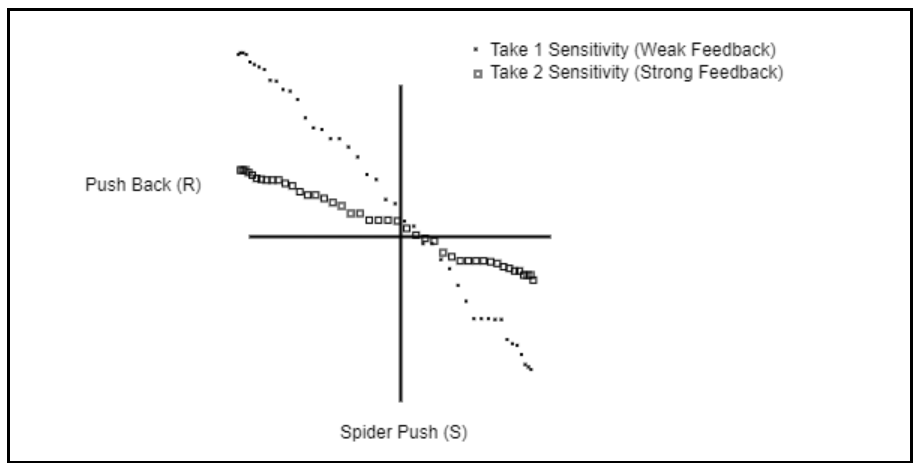The first figure below is the relationship between variables in a PCT experiment. And the second figure below is an example of a PCT experiment. Only the mouse and the disturbance have a high correlation. The cursor and mouse have no correlation. In his reappraisal paper, Rick states that the correlation between mouse and cursor movements is only 0.53. These values are not correlated. I am asking him to show instead the mouse-disturbance correlation because this is where the high correlation lies. And consciousness is where the controlled variable in the first figure below is a reference value.

Â
![]()
Virus-free. www.avast.com
···
On Sun, Mar 11, 2018 at 9:43 AM, Martin Taylor mmt-csg@mmtaylor.net wrote:
[Martin Taylor 2018.03.11.12.24]
On 2018/03/11 1:31 AM, PHILIP JERAIRYERANOSIAN wrote:
Whena person sees that a perception does not cause them to have an
intention, they are conscious because their behavior is now
resisting disturbances to their intention. Consciousness is where
behavior correlates to disturbances of a perception of an
intention.Â"Curioser and curioser". I feel as though I am talking toHumpty-Dumpty and will soon be eating “diminish me” mushrooms or
something. Could you relate what you said in this and your last
message to something connected with PCT as it is normally
understood? Or even to everyday experience?MartinOnSaturday, March 10, 2018, Martin Taylor <mmt-csg@mmtaylor.net >
wrote:[Martin Taylor 2018.03.10.23.31]
On 2018/03/10 11:30 PM, PHILIP JERAIR YERANOSIAN wrote:
If a person perceives that theinternal processes produce f-1( AB) and
assumes that they do it autonomously, independently of
the external environment, that is consciousness.
Explain what that has to do withconsciousness, and whose consciousness you are talking
about, please? Also please explain how this relates to the
topic under discussion, which is the nature of the
Behavioural Illusion, and behind that, why behaviourist
(“Stimulus-Response” or “S-R”) researchers have accepted the
illusory perception as a truth about Nature.Martin
Virus-free.
www.avast.com
On Sat, Mar 10, 2018 at 8:17 PM,
Martin Taylor mmt-csg@mmtaylor.net
wrote:
[Martin Taylor 2018.03.10.23.14]
[philip 2019.03.10]
An observed relationship between theoutput and the disturbance can only describe
the form f(AB). This relationship cannot be
used to describe the form f-1(AB).
If the function f(.) is invertible, itcompletely describes f-1(.), just as the form of a
jigsaw piece determines the form of the piece next
to it in the puzzle. The question is which one is
responsible for the form being what it is. The
Behavioural Illusion is that the internal processes
are responsible, whereas they are capable only of
compensating for the effects between the output and
the CEV that are imposed by the external
environment.These two sentences are the behavioralillusion doctrine. Please refer to the last
paragraph of page 9 of Bill’s paper (1978):Â
Ifone varies a distal stimulus q(d)
and observes that a measure of behavior q(o) shows
a strong regular dependence on
q(d) ,
there is certainly a
temptation to assume that
the form of the
dependence reveals
something about the
organism. Yet, the
comparison we have
just seen indicates
that the form of the
dependence may
reflect only
properties of the
local environment.
TheBehavioural Illusion is in someone’s
perception that the the form of f(AB)
reflects something about f-1(AB).
No. There'sno illusion there. It’s just a simple fact.
Whether you call it a fact of physics or of
mathematics is up to you, but it is not an
illusion.The termf(AB) reflects how the distal stimulus
determines the form of the output.
Yes. The term, f-1 (AB), reflects
how the internal processes determine the
form of the output.Â
If youreplace “how” with “that”, you have a
description of the Behavioural Illusion in
someone’s mind. Another way of putting it is
“The term f-1 (AB) determines what the
internal processes must do in order for control
to be effective, given that the environmental
function is f(AB). If a person perceives that
the internal processes produce f-1( AB)
and assumes that they do it autonomously,
independently of the external environment, that
is the Behavioural Illusion.”Martin
On Sat, Mar 10, 2018
at 2:41 PM, Martin Taylor mmt-csg@mmtaylor.net
wrote:
[Martin Taylor 2018.03.10.17.23]
On 2018/03/10 4:45 PM, PHILIPJERAIR YERANOSIAN wrote:
The behavioralillusion doctrine states that an
experimenter cannot use an
observed relationship between the
output and the disturbance to
describe a dependence between the
input and the output. Nor can this
observed relationship between
output and disturbance be used to
describe a dependence between the
input and disturbance. The purpose
of this doctrine is to prevent an
experimenter from using a shown
dependence to reveal something
about the mechanisms that produce
the output.
Actually, this isn't correct,and there is no “doctrine” involved.
It’s a simple requirement of control
loops. The behavioural illusion is based
on a fundamental fact about negative
feedback loops that stabilize their
variables, and therefore about control
loops that control well. If there is a
functional relation f(AB) between the
variation at point A and the variation
at point B going one way around the
loop, the functional relation f(BA)
going the rest of the way around the
loop is the inverse function: f(BA) = f-1(AB).If "A" is the output, and "B" the CEV,the environmental variable that
corresponds to the controlled perceptual
variable, and if a change in the CEV is
taken to be a “stimulus”, then the
response (output) is determined by the
properties of the environmental link
between A and B. Those properties, which
produce f(AB), are observable, in
principle, and are not influenced by
whatever happens inside the organism.
The internal mechanisms are not
observable, but they must be such as to
produce f(BA) of a specific form, that
form being f-1(AB).The modelling done in simulations toanalyze the mechanisms that produce the
output relies on this fact (and on the
discrepancy from f-1 (AB) that
occurs because of imperfect control).
The Behavioural Illusion is in someone’s
perception that the internal processes
determine the form of the output in a
situation for which control is good.Martin
Virus-free.
www.avast.com
On Fri,
Mar 9, 2018 at 3:04 PM, Richard
Marken rsmarken@gmail.com
wrote:
[Rick
Marken
2018-03-09_15:03:56]
[philip2018.03.09]Â
PY: Thebehavioral illusion
refers to the fact
that the behavior
[where the behavior
is the observable
event we are
referring to] does
not correlate to the
controlled variable
[where the
controlled variable
is the perception
which is influenced
by the behavior].Â
Instead, the
behavior correlates
with the disturbance
[where the
disturbance is an
event that is
influencing the
controlled variable
independent of the
behavior].Â
Â
RM: I prefer the
definition given in
our reply paper:Â Â “…the
behavioral illusion
occurs when an
observed
relationship between
variables is seen
as revealing
something about the
mechanisms that
produce a behavior
when, in fact, it
does not. For
example,
the behavioral
illusion occurs when
“reinforcement� is
seen as “selecting�
the behavior that
produced it (Marken
and Powers 1989; Yin
2013, pp. 342–3343)
or when a tap on the
patellar tendon is
seen as the cause of
the knee-jerk
response (Marken
2014b, p. 123). The
illusion occurs when
the behavior under
study is assumed to
be that of
an open-loop,
cause–effect syystem
when it is actually
that of a
closed-loop control
system (Powers
1978)”.
Best
Rick
Richard
S. MarkenÂ
"Perfection
is achieved
not when you
have nothing
more to add,
but when you
have
nothing left
to take away.�
Â
      Â
      Â
 --Antoine de
Saint-Exupery
–


